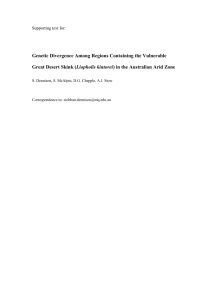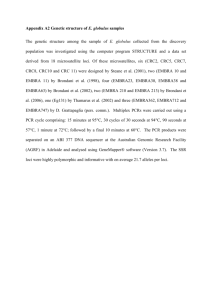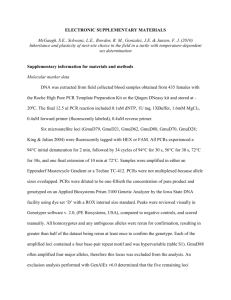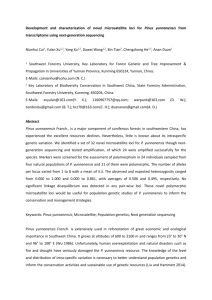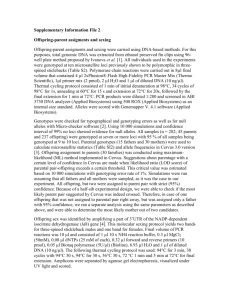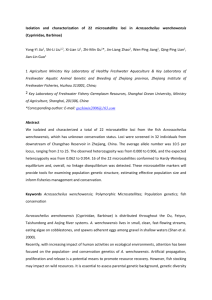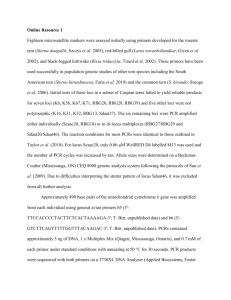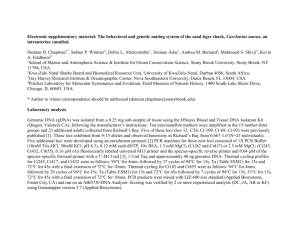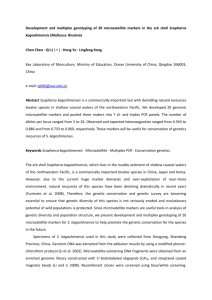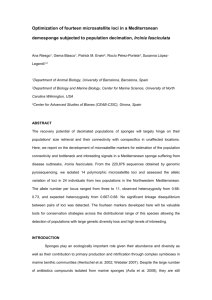Microsatellite discovery in a freshwater siluroid, Bagrus docmak and
advertisement
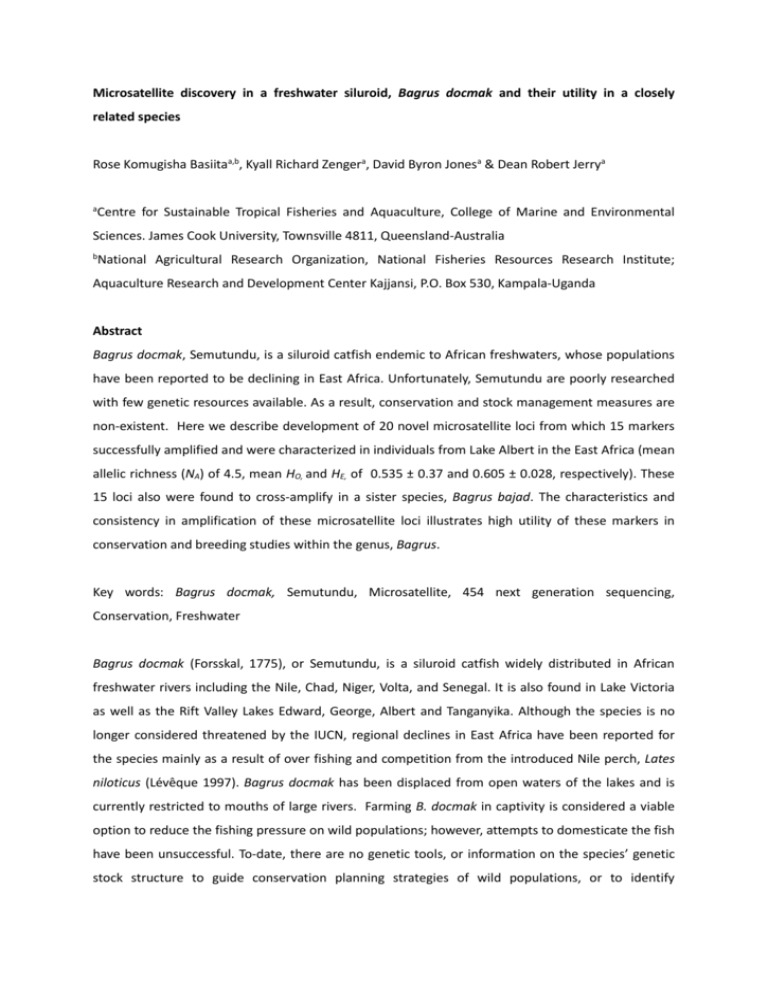
Microsatellite discovery in a freshwater siluroid, Bagrus docmak and their utility in a closely related species Rose Komugisha Basiitaa,b, Kyall Richard Zengera, David Byron Jonesa & Dean Robert Jerrya a Centre for Sustainable Tropical Fisheries and Aquaculture, College of Marine and Environmental Sciences. James Cook University, Townsville 4811, Queensland-Australia b National Agricultural Research Organization, National Fisheries Resources Research Institute; Aquaculture Research and Development Center Kajjansi, P.O. Box 530, Kampala-Uganda Abstract Bagrus docmak, Semutundu, is a siluroid catfish endemic to African freshwaters, whose populations have been reported to be declining in East Africa. Unfortunately, Semutundu are poorly researched with few genetic resources available. As a result, conservation and stock management measures are non-existent. Here we describe development of 20 novel microsatellite loci from which 15 markers successfully amplified and were characterized in individuals from Lake Albert in the East Africa (mean allelic richness (NA) of 4.5, mean HO, and HE, of 0.535 ± 0.37 and 0.605 ± 0.028, respectively). These 15 loci also were found to cross-amplify in a sister species, Bagrus bajad. The characteristics and consistency in amplification of these microsatellite loci illustrates high utility of these markers in conservation and breeding studies within the genus, Bagrus. Key words: Bagrus docmak, Semutundu, Microsatellite, 454 next generation sequencing, Conservation, Freshwater Bagrus docmak (Forsskal, 1775), or Semutundu, is a siluroid catfish widely distributed in African freshwater rivers including the Nile, Chad, Niger, Volta, and Senegal. It is also found in Lake Victoria as well as the Rift Valley Lakes Edward, George, Albert and Tanganyika. Although the species is no longer considered threatened by the IUCN, regional declines in East Africa have been reported for the species mainly as a result of over fishing and competition from the introduced Nile perch, Lates niloticus (Lévêque 1997). Bagrus docmak has been displaced from open waters of the lakes and is currently restricted to mouths of large rivers. Farming B. docmak in captivity is considered a viable option to reduce the fishing pressure on wild populations; however, attempts to domesticate the fish have been unsuccessful. To-date, there are no genetic tools, or information on the species’ genetic stock structure to guide conservation planning strategies of wild populations, or to identify appropriate broodstock source populations for restocking or farming. Accordingly, we developed the first informative microsatellite DNA markers for B. docmak that will have utility in studies aimed at resolving its natural stock structure. DNA from 12 wild B. docmak individuals (three from Lake Victoria and nine from the Nile River) was extracted using a modified CTAB protocol and pooled before Roche 454 FLX sequencing (1/8th of a plate) at the Australian Genome Research Facility in Brisbane. Sequencing returned 160,232 raw reads that have been deposited into Genbank (Accession no. PRJNA276164). Using iQDD (Meglécz et al. 2010), data mining of reads yielded 209 possible microsatellite loci (145 dinucleotides, 37 trinucleotides and 27 tetranucleotides) where primers could be designed (Table S1). Twenty of these loci were synthesised and indirectly labelled with an M13 tag (Shimizu et al. 2002) and screened for polymorphism using a TYPE IT (QIAGEN) PCR microsatellite kit. Fifteen loci that amplified consistently were further directly labelled and characterised in a B. docmak population (N=16) from Lake Albert, East Africa. The markers were also trialled for cross amplification in a closely related taxa, B. bajad (N=5). Optimised PCR conditions were characterised by; an initial denaturation at 95oC for 5 min, 6 cycles of 95oC for 30s (denaturation)/59oC for 90s (annealing)/72oC for 30s (extension), 10 cycles for each reducing annealing temperatures of 57oC, 55oC and 53oC, prior to a final extension at 60oC for 30 min. Genotyping was performed on an ABI-3730 instrument (Applied Biosystems) using a 5-standard dye system (6-FAM, VIC, NED, PET and LIZ GS-500 size standard) at the Georgia Genomics Facility, USA. Alleles were scored using Genemarker 2.4 (Softgenetics) and checked for genotyping errors and null alleles in Microchecker 2.2.3 (Van Oosterhout et al. 2004). Characteristics of the 15 loci computed in GenAlex 6.5 (Peakall & Smouse 2012) are presented in Table 1. The loci were polymorphic with a mean allelic richness, NA, of 4.5 (range 2-7 alleles per locus), and mean observed and expected heterozygosity, HO, and HE, of 0.535 ± 0.37 and 0.605 ± 0.028 respectively except for locus BD16 that was monomorphic in this B. docmak population. Null alleles were also suggested at locus BD07. All markers were found to be polymorphic in the sister species B. bajad (Table 1). The consistency in amplification of the polymorphic microsatellite loci illustrates their utility in conservation genetic studies and parentage assignment in the Genus Bagrus. Acknowledgements We are grateful to Constantine Ondhoro, Philip Lwezawula Cassius Aruho, Matthew Mwanja and Martin Sserwadda who assisted us with sample collection. Funding for sample collection was provided by the National Fisheries Resources Research Institute, Uganda, under the ATAAS project. All laboratory work was done at the Molecular Ecology and Evolution Laboratory at James Cook University, unless otherwise specified. Lab group members are hereby acknowledged for their support. RKB is a PhD student under the AusAID funded ADS scholarship. The authors also declare that there are no conflicts of interest. This research was conducted under Animal ethics permit no. A1824 . References Lévêque C. (1997) Biodiversity Dynamics and Conservation: The Fresh-water Fish of Tropical Africa. Cambridge University Press. Meglécz E., Costedoat C., Dubut V., Gilles A., Malausa T., Pech N. & Martin J.-F. (2010) QDD: a user-friendly program to select microsatellite markers and design primers from large sequencing projects. Bioinformatics 26, 403-4. Peakall R. & Smouse P.E. (2012) GenAlEx 6.5: genetic analysis in Excel. Population genetic software for teaching and research—an update. Bioinformatics 28, 2537-9. Shimizu M., Kosaka N., Shimada T., Nagahata T., Iwasaki H., Nagai H., Shiba T. & Emi M. (2002) Universal fluorescent labeling (UFL) method for automated microsatellite analysis. DNA research 9, 173-8. Van Oosterhout C., Hutchinson W.F., Wills D.P. & Shipley P. (2004) MICRO‐CHECKER: software for identifying and correcting genotyping errors in microsatellite data. Molecular Ecology Notes 4, 535-8.

